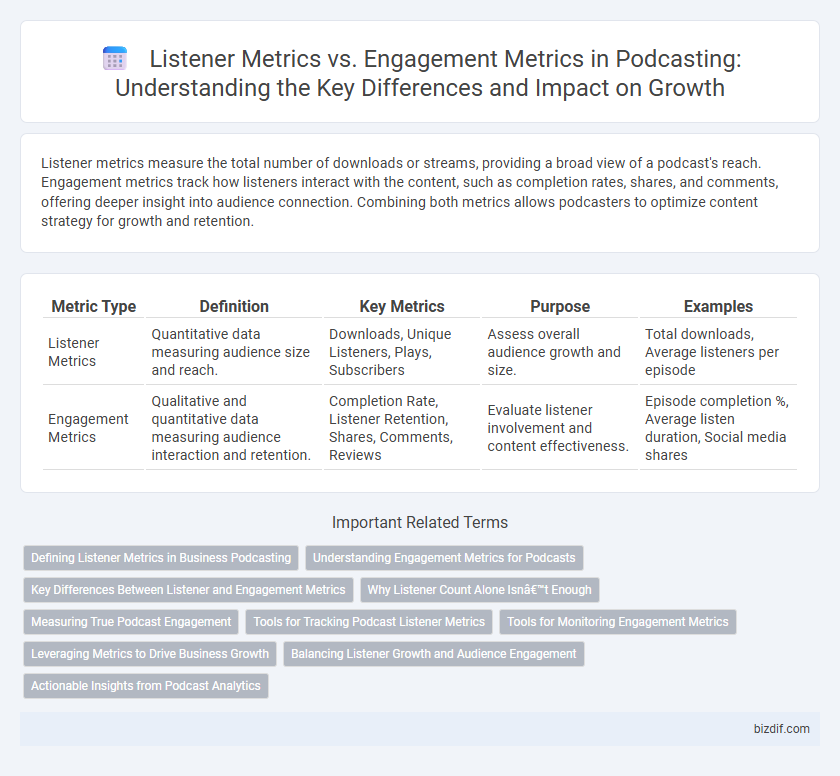Listener metrics measure the total number of downloads or streams, providing a broad view of a podcast's reach. Engagement metrics track how listeners interact with the content, such as completion rates, shares, and comments, offering deeper insight into audience connection. Combining both metrics allows podcasters to optimize content strategy for growth and retention.
Table of Comparison
| Metric Type | Definition | Key Metrics | Purpose | Examples |
|---|---|---|---|---|
| Listener Metrics | Quantitative data measuring audience size and reach. | Downloads, Unique Listeners, Plays, Subscribers | Assess overall audience growth and size. | Total downloads, Average listeners per episode |
| Engagement Metrics | Qualitative and quantitative data measuring audience interaction and retention. | Completion Rate, Listener Retention, Shares, Comments, Reviews | Evaluate listener involvement and content effectiveness. | Episode completion %, Average listen duration, Social media shares |
Defining Listener Metrics in Business Podcasting
Listener metrics in business podcasting quantify the size and demographics of the audience, capturing data such as total downloads, unique listeners, and average listen duration. These metrics provide insights into reach and audience growth, enabling businesses to measure the effectiveness of content distribution strategies. Accurately tracking listener metrics helps identify target market segments and optimize marketing efforts to enhance brand awareness.
Understanding Engagement Metrics for Podcasts
Engagement metrics for podcasts measure how listeners interact with content beyond just download numbers, including average listen duration, completion rate, and repeat listens. These metrics provide deeper insight into audience behavior, revealing how compelling and relevant the content is to the target audience. Analyzing engagement metrics helps podcasters refine their content strategy to boost listener retention and foster a loyal community.
Key Differences Between Listener and Engagement Metrics
Listener metrics quantify the size and demographics of a podcast audience, including downloads, unique listeners, and subscriber counts. Engagement metrics assess how actively listeners interact with the content, measuring factors such as average listening duration, episode completion rates, and listener feedback. Understanding these key differences is crucial for podcasters to tailor content strategies that boost both audience reach and listener involvement.
Why Listener Count Alone Isn’t Enough
Listener count provides a basic measure of a podcast's reach but fails to capture audience engagement, which is critical for understanding content impact and loyalty. Engagement metrics such as average listen duration, episode completion rate, and interaction through comments or social shares reveal deeper insights into listener behavior and content effectiveness. Relying solely on listener count risks overlooking valuable data that drive advertiser interest and content improvement strategies.
Measuring True Podcast Engagement
Listener metrics quantify the total downloads and unique audience size, providing a broad understanding of reach and exposure. Engagement metrics delve deeper, analyzing listener behavior such as average listen duration, completion rates, and interaction through shares or comments, revealing the quality of audience connection. Measuring true podcast engagement requires focusing on these behavioral insights to assess how content resonates and retains listeners beyond initial downloads.
Tools for Tracking Podcast Listener Metrics
Podcast analytics platforms such as Chartable, Podtrac, and Spotify for Podcasters provide comprehensive listener metrics including downloads, unique listeners, and geographic demographics. Engagement metrics, measured through tools like Listen Notes and Podmetrics, track listener behavior such as average listen duration, drop-off points, and episode shares. Utilizing these specialized tools allows podcasters to gain detailed insights into audience size and engagement patterns, optimizing content strategy and marketing efforts.
Tools for Monitoring Engagement Metrics
Tools like Chartable, Podtrac, and Podmetrics provide detailed listener engagement metrics by tracking episode downloads, listener retention, and interaction rates. Platforms such as Anchor and Spotify for Podcasters offer insights into audience demographics, listening patterns, and episode popularity to optimize content strategy. These monitoring tools enable podcasters to measure not only reach but also listener behavior, helping refine show formats and increase audience loyalty.
Leveraging Metrics to Drive Business Growth
Listener metrics such as total downloads and unique listeners provide a quantitative foundation for understanding audience size and reach in podcasting. Engagement metrics, including average listen duration, listener retention rate, and episode completion percentage, offer deeper insights into audience behavior and content effectiveness. Leveraging both types of metrics enables podcasters to tailor content strategies, enhance listener loyalty, and drive targeted marketing efforts that contribute to sustainable business growth.
Balancing Listener Growth and Audience Engagement
Listener metrics such as download counts and unique listeners provide a clear measure of podcast growth and reach, while engagement metrics like average listen duration, comments, and shares reveal audience connection and content impact. Balancing these metrics is crucial; high listener numbers without strong engagement can indicate passive consumption, whereas high engagement with limited growth may restrict overall market reach. Optimizing podcast strategy requires integrating both metrics to attract new listeners and cultivate a loyal, interactive audience.
Actionable Insights from Podcast Analytics
Listener metrics quantify total downloads, unique plays, and average listen duration, providing baseline data on audience size and reach. Engagement metrics analyze listener interactions such as episode completion rates, skip behavior, listener retention, and shares to reveal content resonance and audience loyalty. Combining these analytics generates actionable insights that enable podcasters to optimize episode length, refine content strategies, and tailor marketing efforts for higher retention and growth.
Listener Metrics vs Engagement Metrics Infographic

 bizdif.com
bizdif.com